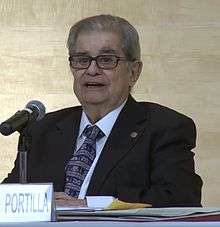Miguel León-Portilla
| Miguel León-Portilla | |
|---|---|
 | |
| Born | February 22, 1926 |
| Nationality | Mexican |
| Occupation | Philosopher, anthropologist, historian |
Miguel León-Portilla (born February 22, 1926 in Mexico City) is a Mexican anthropologist and historian, and a prime authority on Nahuatl thought and literature.[1]
Career
He wrote his doctoral thesis on Nahua philosophy under the tutelage of Fr. Ángel María Garibay K., a notable researcher and translator of primary Nahuatl source documents, whose publications in the 1930s and 1940s first brought Nahuatl literature to widespread public attention. With Garibay, León-Portilla made contributions to the study of nineteenth-century Mesoamerican historian Manuel Orozco y Berra.[2][3] He established his reputation as an expert through translating, interpreting and publishing several recompilations of Nahuatl works.
León-Portilla has spearheaded a movement to understand and reevaluate Nahuatl literature, not only from the pre-Columbian era, but also that of the present day – Nahuatl is still spoken by 1.5 million people.[1] He has contributed to establishing bilingual education in rural Mexico.
León-Portilla was also instrumental in bringing to light the works of Fr. Bernardino de Sahagún, a 16th-century primary source on the Aztec civilization and whose works have become one of the major references for cultural and historical information on Postclassic central Mexico. León-Portilla was the first to acclaim Sahagún as the "Father of Anthropology in the New World", an appellation which has since become a commonplace, although by no means universally held, viewpoint.
Sahagún recorded the knowledge of three independent groups of Nahuatl elders (tlamatini), in their own language, he compared the different versions and then he questioned again to resolve the differences, then he arranged, so the Aztec Tlacuilos (codex painters) made the illustrations of his work. At the request of Spanish authorities, he wrote a bowdlerized version in Spanish (the Historia general de las cosas de Nueva España), but his original work, the Florentine Codex, was never published. Before León-Portilla, it had only been translated once (into German), and even that was incomplete.
As a historian, León-Portilla gives us an understanding of the figure of Tlacaelel. Originally, an obscure name in some chronicles, Tlacaelel is now seen by many as the architect of the Aztec empire.
A subordinate but important interest of León-Portilla has been the early history and ethnography of the Baja California Peninsula. He has addressed this region in more than 30 books and articles, including a 1995 volume collecting several of his earlier publications.[4]
Through his work, León-Portilla has obtained several academic degrees and decorations including the Belisario Domínguez Medal of Honor. In 1995, he was elected to membership of the National Academy of Sciences. On December 12, 2013, León-Portilla received the Living Legend Award from the U.S. Library of Congress.[1]
References
- 1 2 3 "Miguel León-Portilla to Receive Living Legend Award at Celebration of Mexico, Dec. 12". US Library of Congress. November 20, 2013. ISSN 0731-3527. LOC-PR 13-206. Retrieved November 20, 2013.
- ↑ Miguel León-Portilla, "Orozco y Berra: investigador del pensamiento náhuatl" in La filosofía náhuatl estudiada en sus fuentes. Mexico, UNAM 1959, ppp. 32–33.
- ↑ Miguel León-Portilla. "Bibliografía de don Manuel Orozco y Berra.". In Historia antigua y de la conquista de México por Manuel Orozco y Berra. Nueve edición preparada por A.M. Garibay K. y Miguel León-Portilla. 4 vols. Mexico: Porrúa, 1960.
- ↑ León-Portilla, Miguel. 1995. La California mexicana: ensayos acerca de su historia. Universidad Nacional Autónoma de México, Mexico City.
External links
- Miguel León-Portilla (El Colegio Nacional) (Spanish)
- Academia Mexicana de la Historia: Miguel León-Portilla (Spanish)
| Preceded by Jaime Sabines Gutiérrez |
Belisario Domínguez Medal of Honor 1995 |
Succeeded by Griselda Alvarez Ponce de León |